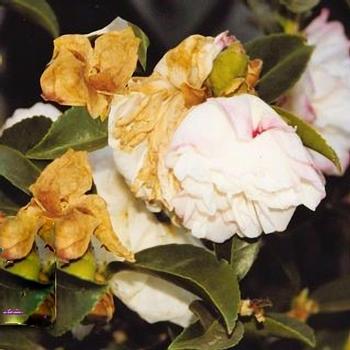Camellia, azalea and rhododendron flower blights
-
Martha Proctor
-
For several years I have been dealing with a common problem that specifically affects camellias called camellia flower blight and caused by the fungus Ciborinia camelliae. In the spring when the flowers appear, small, brown irregularly-shaped blotches develop on the petals. These blotches grow larger and eventually the flower turns brown and dies. Infected petals develop prominent dark brown veins which gives them a netted appearance. Affected flowers often fall off the plant prematurely, often as intact flowers. The disease only affects the flower so occurs solely while the plant is in flower.
 C. Sasanqua with petal blight. Photo credit: UC MMG Instagram
C. Sasanqua with petal blight. Photo credit: UC MMG InstagramCamellias infected with Ciborinia camelliae develop dark, hard, irregularly-shaped black nesting structures called sclerotia within the base of the decaying petals. These survive after the flower dies and remain dormant in the soil during the winter. The sclerotia germinate as the plant comes into flower the following year. They produce small, brown cup-shaped reproductive structures called apothecia which sometimes can be found on the soil surface below an affected plant. These apothecia release huge numbers of spores, some of which are carried upwards in air currents to the flowers of the plant. Spores have been known to lie dormant in the soil for several years and travel on the wind up to 12 miles. To infect the flower, the petals need to be wet, so infections are more common in mild (59oto 70oF), wet weather.
Azaleas and rhododendrons are another plant species that are highly susceptible to another fungal flower blight called Ovulinia petal blight. Ovulina azaleae infects flowers of both native and introduced azaleas and rhododendron as well as mountain laurel, especially where there are heavy morning fogs. The fungi cause disease which results in the premature death of blossoms. Drooping, wet flower petals remain attached or tumble onto nearby leaves.
The Ovulinia fungi infect wet blossoms when temperatures are mild, 50o to 70oF. Similar to the camellia petal blight, this fungus infects only the petals of blossoms, causing white to brownish spots that can enlarge rapidly. This fungus produces sclerotia, that are black, flattened, irregularly-shaped and approximately one-eighth inch to two-fifths inch long. As with camellias, the resultant apothecia forcibly discharge large numbers of spores that are carried by the wind onto emerging blooms where they germinate. The spores are also spread by insects, especially bumble bees. This makes it possible for the fungus to spread between many blossoms within several days of an initial infection.
Using sanitary practices in the garden is the best way to control this disease. Remove and dispose of fallen, old, and infected flowers. Do not add camellia, azalea or rhododendron petals or leaves to composting piles or mulch as it’s almost impossible to heat the compost pile to 140oF, the temperature required to kill the petal blight fungi. Remove the top layer of potting soil when new azalea, camellia or rhododendron are purchased and replace it with pathogen-free soil. Plant in a well-ventilated location. Avoid overhead irrigation. Use drip or micro-sprinkler irrigation instead.
If cultural methods fail to provide adequate control, consider applying an appropriate fungicide such as chlorothalonil, thiphanate methyl, or triforine one month prior to bud break or before any rainy weather to help reduce the chance of infection. Reapplication may be warranted every 10-14 days while foggy or rainy conditions continue. If petal blight is persistent, gradually replace susceptible plants with resistant plants. Best results ensue when good sanitation and cultural practices are followed.
The best prevention for any fungi or pest infestation is a healthy plant. For the best performance, plant camellia, azalea or rhododendron plants properly to maintain good health. Space plants well and prune them to provide good air circulation.
Each year after blossoms are spent, apply a fresh layer of uncontaminated organic mulch between host plants. Maintain a four-inch mulch layer to help suppress Ovulinia and Ciboroinia camelliae petal blights in the soil. Keep mulch several inches away from the trunks of the plants.

